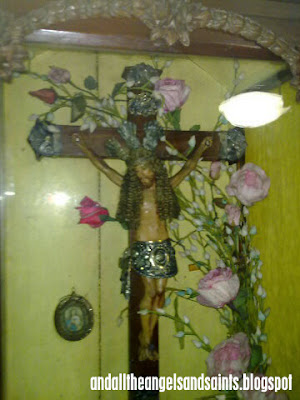There are two devotional articles that are considered indispensable in every Filipino home. One is a statue of the Blessed Virgin, and the other is a Crucifix. Since the early days of our Christianization, the crucifix--showing Jesus Christ crucified on the Cross--has been a sacred object of veneration, whether carved crudely from wood, fashioned from expensive ivory, or commissioned from a religious talyer in Quiapo.
Here then are different crucifixes of varied materials and styles, seen over the years in antique shops and dealers' stores, but all exalting the glorious death of Jesus Christ.
METAL CRUCIFIX. The corpus of Christ of cast metal is nailed on an ebony crosstrimmed with brass rays and finials. The cross stands on a wooden stoney base, that is encased in a glass dome.
FOLK CRUCIFIX. The figure of Christ, with its original paint, wears a loin cloth and tres potencias of beaten tin. The kamagong cross, too, features rays made of cheap tin.
TABLETOP CRUCIFIX. Offered by an online dealer, this folksy crucifix shows a nicely-proportioned Jesus Christ mounted on a softwood cross, trimmed with simple cantoneras of tin.
CLASSIC CRISTO. A classically carved Christ, complete with glass eyes and etched loincloth of silver hangs on a kamagong cross. The bloodied figure is missing its rays and crown of thorns,
CRISTO MORIBUNDO. A wooden Christ, with his head down, hangs limp on a cross. It is handsomely attired with a silver loincloth with repoussed design.
NATIVE CRUCIFIX. A rather stiff rendition of Christ in wood, on a kamagong cross, has folksy features, but is splendidly arrayed in silver accessories, including the skull-and-bones at the foot of the cross.
PRIMITIVE CRUCIFIX. This naive crucifix must have been carved by an untrained artisan from softwood. It bears traces of paint and gesso.
HEIRLOOM CRUCIFIX. Made of fine wood, this crucifix shows a well-carved Jesus Christ that has kept all its important accessories thru the years--from its wig to its high potencias and polished silver loincloth. The kamagong cross is trimmed with beaten silver and is kept in a family urna.
VINTAGE CRUCIFIX. The wooden figure of Jesus Christ shows a well-carved physique, which is in sharp contrast to the simple cross on where he hangs. The rays of the cross are fashioned from tin.


























